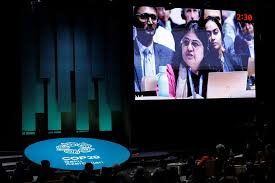CNN Central News & Network–ITDC India Epress/ITDC News Bhopal: Hello! Welcome to ITDC News’ Site Insight.
At the COP29 Climate Conference, India rejected the ₹25 lakh crore ($300 billion) proposal by wealthy nations, calling it “inadequate” and “peanuts.” The question is, why did India take this bold step? Let’s dive into this detailed analysis to uncover the full story.
[What is COP29?]
First, let’s understand COP29. COP stands for Conference of the Parties, an annual international meeting where 197 countries discuss strategies to combat climate change. This year’s conference was held in Baku, Azerbaijan, with the theme “Climate Finance”, focusing on funding initiatives to address climate change.
The conference aimed to determine how and how much financial support developed countries would provide to developing nations to combat climate challenges. Under this framework, a proposal for annual funding of $300 billion until 2035 was presented.
[The ₹25 Lakh Crore Proposal and Its Objectives]
The $300 billion (₹25 lakh crore) funding was proposed with four primary objectives:
Promoting renewable energy sources like solar, wind, and hydro energy.
Assisting developing nations in tackling climate disasters.
Investing in green technologies such as hydrogen energy and carbon capture.
Providing financial aid to regions affected by climate change.
[Why Did India Reject This Deal?]
India dismissed the proposal, stating that the funding was insufficient to meet the challenges of climate change. India’s representative, Chandni Raina, asserted at COP29:
“India does not accept this proposal. The amount neither helps us achieve our goals nor respects our right to development.”
Experts also believe that such a small amount cannot help developing nations achieve their climate targets. India argued that this funding was essentially a way for developed nations to impose stringent pollution control measures on developing countries.
[The Developed vs. Developing Nations Dispute]
India’s stance highlights the historical responsibility of developed nations for the climate crisis. During the industrial revolution, these nations were the largest emitters of greenhouse gases. Now, they are imposing strict regulations on developing nations, potentially hindering their industrial growth.
India emphasized that developed countries must first reduce their greenhouse gas emissions and then provide equitable support to developing nations.
[India’s Stand and the Way Forward]
At COP29, India reaffirmed its commitment to tackling climate change but demanded equality and respect, not “token financial aid.” India is determined to progress on its goals through its resources and smart industrialization.
[Conclusion]
India’s stance at COP29 underscores its expectation of genuine commitments from global leaders to combat climate change. The question remains: Are developed countries ready to take responsibility? The answer will shape the future of global climate action.
For more in-depth analyses and the latest news, stay tuned to ITDC News.
#IndiaEconomy #25LakhCrore #EconomicDecision #ITDCNews #DeepAnalysis







